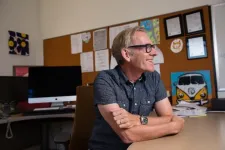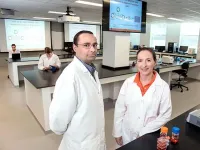(Press-News.org) As meat-eating continues to increase around the world, food scientists are focusing on ways to create healthier, better-tasting and more sustainable plant-based protein products that mimic meat, fish, milk, cheese and eggs.
It's no simple task, says renowned food scientist David Julian McClements, University of Massachusetts Amherst Distinguished Professor and lead author of a paper in the new Nature journal, Science of Food, that explores the topic.
"With Beyond Meat and Impossible Foods and other products coming on the market, there's a huge interest in plant-based foods for improved sustainability, health and ethical reasons," says McClements, a leading expert in food design and nanotechnology, and author of Future Foods: How Modern Science Is Transforming the Way We Eat.
In 2019, the plant-based food market in the U.S. alone was valued at nearly $5 billion, with 40.5% of sales in the milk category and 18.9% in plant-based meat products, the paper notes. That represented a market value growth of 29% from 2017.
"A lot of academics are starting to work in this area and are not familiar with the complexity of animal products and the physicochemical principles you need in order to assemble plant-based ingredients into these products, each with their own physical, functional, nutritional and sensory attributes," McClements says.
With funding from the USDA's National Institute of Food and Agriculture and the Good Food Institute, McClements leads a multidisciplinary team at UMass Amherst that is exploring the science behind designing better plant-based protein. Co-author Lutz Grossmann, who recently joined the UMass Amherst food science team as an assistant professor, has expertise in alternative protein sources, McClements notes.
"Our research has pivoted toward this topic," McClements says. "There's a huge amount of innovation and investment in this area, and I get contacted frequently by different startup companies who are trying to make plant-based fish or eggs or cheese, but who often don't have a background in the science of foods."
While the plant-based food sector is expanding to meet consumer demand, McClements notes in the paper that "a plant-based diet is not necessarily better than an omnivore diet from a nutritional perspective."
Plant-based products need to be fortified with micronutrients that are naturally present in animal meat, milk and eggs, including vitamin D, calcium and zinc. They also have to be digestible and provide the full complement of essential amino acids.
McClements says that many of the current generation of highly processed, plant-based meat products are unhealthy because they're full of saturated fat, salt and sugar. But he adds that ultra-processed food does not have to be unhealthy.
"We're trying to make processed food healthier," McClements says. "We aim to design them to have all the vitamins and minerals you need and have health-promoting components like dietary fiber and phytochemicals so that they taste good and they're convenient and they're cheap and you can easily incorporate them into your life. That's the goal in the future, but we're not there yet for most products."
For this reason, McClements says, the UMass Amherst team of scientists is taking a holistic, multidisciplinary approach to tackle this complex problem.
INFORMATION:
Physicists in Israel have created a quantum interferometer on an atom chip. This device can be used to explore the fundamentals of quantum theory by studying the interference pattern between two beams of atoms. University of Groningen physicist, Anupam Mazumdar, describes how the device could be adapted to use mesoscopic particles instead of atoms. This modification would allow for expanded applications. A description of the device, and theoretical considerations concerning its application by Mazumdar, were published on 28 May in the journal Science Advances.
The device which scientists from the Ben-Gurion University of the Negev created is a so-called Stern Gerlach Interferometer, which was first proposed one hundred years ago by German physicists Otto Stern and Walter ...
Researchers in Lund, Copenhagen and Norwich have shown that harmful mutations present in the DNA play an important - yet neglected - role in the conservation and translocation programs of threatened species.
"Many species are threatened by extinction, both locally and globally. For example, we have lost about ten vertebrate species in Sweden in the last century. However, all these species occur elsewhere in Europe, which means that they could be reintroduced into Sweden. Our computer simulations show how we could theoretically maximize the success of such reestablishments", says Bengt Hansson, biologist at Lund University.
In a new study published in Science, the researchers investigated which individuals might be most suited for translocation ...
The COVID-19 pandemic forced instructors to adapt their courses for online learning. Laboratory courses were particularly difficult due to lack of access to specialized equipment for remote learners. To overcome this challenge, researchers from the University of Illinois Urbana-Champaign designed a laboratory exercise to teach students how to use micropipettes, through remote learning, using at-home kits.
Micropipettes are common--and essential--laboratory instruments and are used in several fields including molecular biology, microbiology, and biochemistry. They are used to accurately transfer very small volumes of liquid. To teach students how to use these instruments, the researchers developed kits, costing $135 per student, that were a fraction ...
COLUMBUS, Ohio - New research suggests that African American families living in public housing are a "hidden population" when it comes to national suicide prevention efforts.
The study showed 11% of Black teens and young adults living in a mid-Atlantic public housing development reported that in the previous 12 months, they had made a plan to die by suicide.
The finding fits with what previous research has shown: that African American youths are the fastest-growing group engaging in suicidal behavior and dying by suicide, and have the highest suicide death rate increase among any other racial or ethnic minority group, ...
How plants cope with stress factors has already been broadly researched. Yet what happens when a plant is confronted with two stressors simultaneously? A research team working with Simon Haberstroh and Prof. Dr. Christiane Werner of the Chair of Ecosystem Physiology at the Institute of Forest Sciences and Natural Resources (UNR) of the University of Freiburg is investigating this. Together with colleagues from the Forest Research Center of the School of Agriculture of the University of Lisbon in Portugal and the Institute of Meteorology and Climate Research at ...
Highlights
Among adults with kidney failure undergoing hemodialysis in New York City, Black and Hispanic patients were more likely to develop symptomatic COVID-19 than White patients.
Neighborhood-level social vulnerability factors were associated with COVID-19 incidence among White patients, but these factors did not explain racial/ethnic disparities.
Washington, DC (June 1, 2021) -- In an analysis of patients on hemodialysis in New York City, there were substantial racial/ethnic disparities in COVID-19 rates that were not explained by neighborhood social vulnerability. The findings appear in an upcoming ...
LOWELL, Mass. - A UMass Lowell geologist is among the researchers who have discovered a new type of manmade quasicrystal created by the first test blast of an atomic bomb.
The formation holds promise as a new material that could one day help repair bone, insulate heat or convert heat to electricity, among other uses, according to UMass Lowell Prof. G. Nelson Eby, a member of the university's Environmental, Earth and Atmospheric Sciences Department.
Eby is a member of the research team that identified the quasicrystal substance inside samples of trinitite they examined that were collected from the debris of the first atomic bomb detonated by the U.S. Army on July 16, 1945 in the New Mexico desert. Also known as atomic rock, trinitite ...
New York, NY, June 3, 2021 -- A study of over 59,000 Icelandic adolescents by a team of Icelandic and North American behavioral and social scientists found that COVID-19 has had a significant, detrimental impact on adolescent mental health, especially in girls. The study is the first to investigate and document age- and gender-specific changes in adolescent mental health problems and substance use during the COVID-19 pandemic, while accounting for upward trends that were appearing before the pandemic. The findings are published in The Lancet Psychiatry.
The study found that negative mental health outcomes were disproportionately reported by girls and older adolescents (13-18-year-olds), compared to same-age peers prior to the pandemic. At the same ...
A first encounter with the dengue virus typically causes very mild symptoms; however, a subsequent infection is a different story. For a small proportion of people who are reinfected, the virus can cause severe symptomatic disease, which is often life-threatening.
"The main hypothesis for some time has been that antibodies generated the first time around, instead of providing protection against disease, can actually exacerbate it," says Stylianos Bournazos, research assistant professor at Rockefeller. "But even in secondary infection, we see a wide range of symptoms--so ...
As India continues to be ravaged by the pandemic, a Swansea University academic is investigating how green tea could give rise to a drug capable of tackling Covid-19.
Dr Suresh Mohankumar carried out the research with colleagues in India during his time at JSS College of Pharmacy, JSS Academy of Higher Education and Research in Ooty prior to taking up his current role at Swansea University Medical School.
He said: "Nature's oldest pharmacy has always been a treasure of potential novel drugs and we questioned if any of these compounds could assist us in battling the Covid-19 pandemic?
"We screened and sorted a library of natural compounds already know to be active against other coronaviruses using an artificial ...


